Nash's work is an attempt to go beyond the merely apparent, beyond the surface of things. As he wrote in his autobiography: ..'it was always the inner life of the subject rather than its characteristic lineaments which appealed to me, though that life, of course, is inseparable, actually, from its physical features'.*
 The son of a successful lawyer and a mentally unstable mother who died in a mental asylum in 1910, Nash was born in London on 11 May 1889. He was educated at St Paul's School,
The son of a successful lawyer and a mentally unstable mother who died in a mental asylum in 1910, Nash was born in London on 11 May 1889. He was educated at St Paul's School, and originally intended for a career in the Navy, like his maternal grandfather. However, he failed his exams, and decided instead to take up art as a career. Studying first at the Chelsea Polytechnic, he went on to the London County Council School of Photo-engraving and Lithography,
and originally intended for a career in the Navy, like his maternal grandfather. However, he failed his exams, and decided instead to take up art as a career. Studying first at the Chelsea Polytechnic, he went on to the London County Council School of Photo-engraving and Lithography,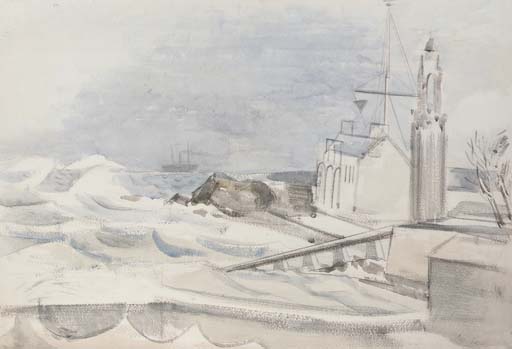 ABOVE SWANAGE
ABOVE SWANAGE
where his work was spotted and praised by Selwyn Image. He was advised by his friend, the poet Gordon Bottomley, and by the artist William Rothenstein
and by the artist William Rothenstein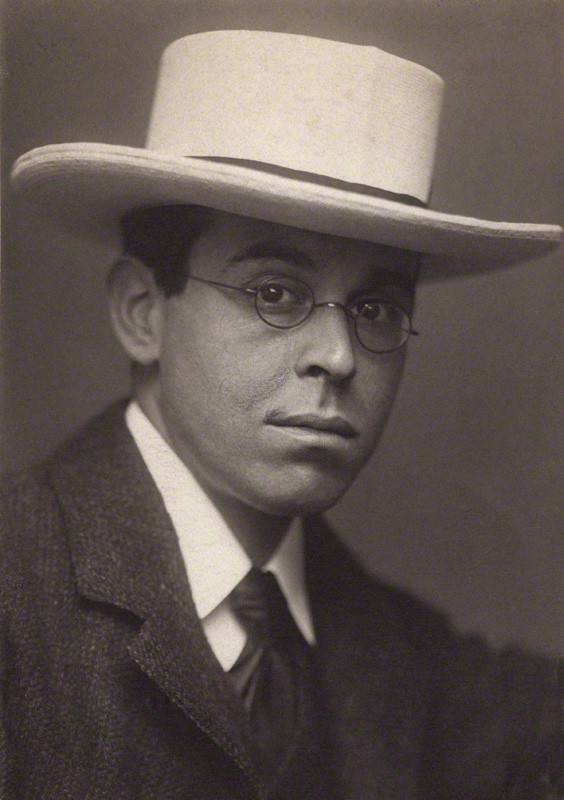 , that he should attend the Slade School of Art at University College, London.below where nash lived in london Queen Alexandra Mansions, Bidborough Street, WC1
, that he should attend the Slade School of Art at University College, London.below where nash lived in london Queen Alexandra Mansions, Bidborough Street, WC1 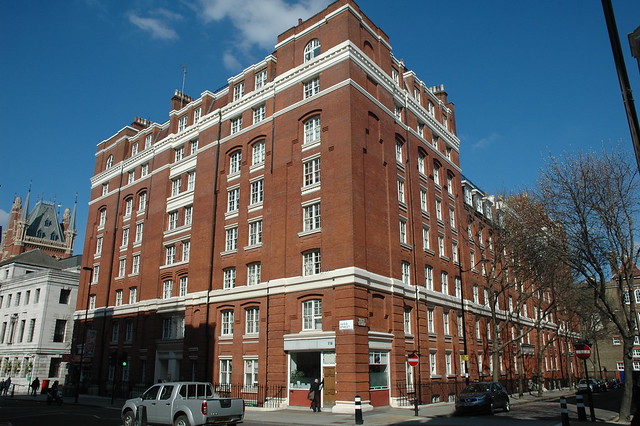 He enrolled there in October 1910, though he later recorded that on his first meeting with the Professor of Drawing, Henry Tonks
He enrolled there in October 1910, though he later recorded that on his first meeting with the Professor of Drawing, Henry Tonks , 'It was evident he considered that neither the Slade, nor I, were likely to derive much benefit'.
, 'It was evident he considered that neither the Slade, nor I, were likely to derive much benefit'.
Nash found much inspiration in British landscape, particularly landscapes with a sense of ancient history, such as burial mounds, Iron Age hill forts such as Wittenham Clumps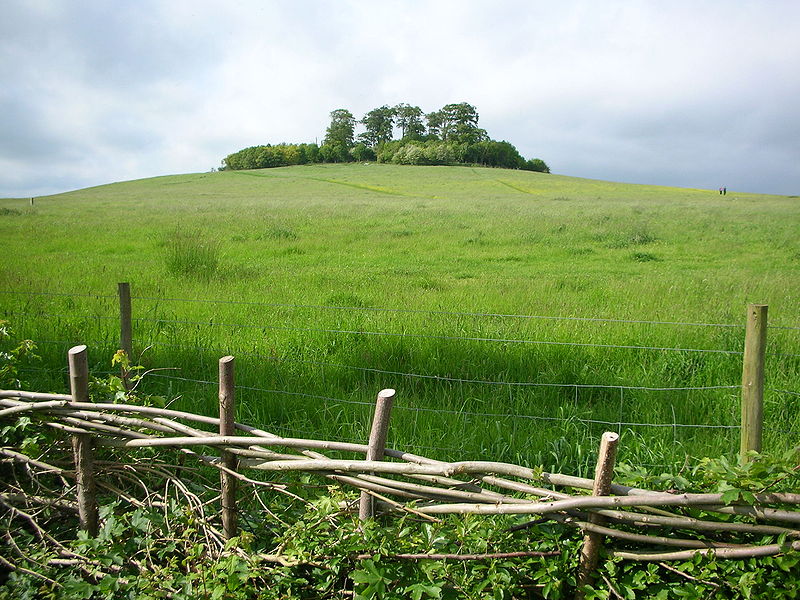 and the standing stones at Avebury in Wiltshire.
and the standing stones at Avebury in Wiltshire. When in 1932 he was invited to illustrate a book of his own choice Nash unhesitating choose Sir Thomas Browne's Urn Burial and The Garden of Cyrus providing the publisher with a set of no less than 32 illustrations to accompany Browne's Discourses. In his final years, he also returned to the influence of Blake that had so affected his early art, for example in the series of gigantic sunflowers including Sunflower and Sun (1942) and Eclipse of the Sunflower (1945) based on Blake's poem Ah! Sunflower.In 1914 Nash married Margaret Odeh, an Oxford-educated campaigner for Women's Suffrage. They had no children.
When in 1932 he was invited to illustrate a book of his own choice Nash unhesitating choose Sir Thomas Browne's Urn Burial and The Garden of Cyrus providing the publisher with a set of no less than 32 illustrations to accompany Browne's Discourses. In his final years, he also returned to the influence of Blake that had so affected his early art, for example in the series of gigantic sunflowers including Sunflower and Sun (1942) and Eclipse of the Sunflower (1945) based on Blake's poem Ah! Sunflower.In 1914 Nash married Margaret Odeh, an Oxford-educated campaigner for Women's Suffrage. They had no children.

Margaret Odeh:
“Margaret was private secretary to the organiser of the Tax Resistance League, a Suffrage organisation that helped women who refused to pay their taxes. One activity Margaret organised was the auctions where non-payers were forced to sell off their possessions in lieu of their tax debts. Nash accompanied her to a sale in Tottenham Court Road, and was astounded at what happened … the women speakers ‘stormed and shouted against the hooting crowd,’ some of whom threw mud, stones and eggs, whilst ‘Government men’ stirred up the trouble. The worst protesters were medical students. ‘What you want, sweetheart,’ one growled, grinning into Margaret’s face, ‘is raping.’ She struck him across the face with a horsewhip and drew blood. Standing on top of a horse-drawn milk cart, brandishing her whip, Nash likened her to ‘a new kind of Boadicea, scattering the enemy hordes.’
"When I was young, my parents used to keep bees on a wooded patch of land outside our home town of Newbury. I was always curious about the old ruins on the site amidst the trees, which suggested a house had once stood there. A manmade lake, now stagnant and dark, stood in the grounds, and away from the buzzing of the beehives the atmosphere was made eerie by looming specimen trees clearly planted by human hands. It was only much later in life, after starting my undergraduate degree in history, that I began delving into the story of what the ruins had been.

What I found astonished me. The house had been an old mansion by the name of Cope Hall – and besides an illustrious past that took in the Civil War and several generations of keen Victorian gardeners who had built the extensive grounds, the Hall harboured a secret. During the dying days of World War One, it had played host to a reformatory for female prostitutes, known as the Women’s Training Colony. There, in the leafy fastness of the Home Counties, ‘fallen women’ from the heart of Edwardian London had been sent to learn arts-and-crafts skills and fashion a new life for themselves in the fresh air. It was a story that, I discovered, had lain hidden within dusty archives and under the ruins of Cope Hall for eighty years, and I was to be the first to re-tell it. So fascinating was the story behind the Women’s Training Colony, that I decided to make it the subject of my undergraduate dissertation; you can find the full document for download below. But for those of you who can’t stomach 12,000 words, here’s a quick taster.
gardeners who had built the extensive grounds, the Hall harboured a secret. During the dying days of World War One, it had played host to a reformatory for female prostitutes, known as the Women’s Training Colony. There, in the leafy fastness of the Home Counties, ‘fallen women’ from the heart of Edwardian London had been sent to learn arts-and-crafts skills and fashion a new life for themselves in the fresh air. It was a story that, I discovered, had lain hidden within dusty archives and under the ruins of Cope Hall for eighty years, and I was to be the first to re-tell it. So fascinating was the story behind the Women’s Training Colony, that I decided to make it the subject of my undergraduate dissertation; you can find the full document for download below. But for those of you who can’t stomach 12,000 words, here’s a quick taster.

Edwardian Britain was a society that still viewed prostitution with no small degree of suspicion. Though the stigma attached to prostitutes had faded since the dark days of the Contagious Diseases Acts – when women suspected of harbouring venereal disease could be locked up and subjected to compulsory inspection – the prevailing attitude was still one of ensuring ‘social purity’ through penalising female prostitutes rather than their clientele. Social work was still dominated by Christian missions and probation for young people in its infancy. Into this unpromising environment was born an intriguing new organisation: the Committee for Social Investigation and Reform (CSIR). Its grandiose name was highly establishment, but its founders and associates were not; many came from the suffragist and suffragette movements, with big-name donors including Elizabeth Garrett Anderson and Millicent Fawcett . One of the principal founders of the organisation was Margaret Odeh, the wife of wartime artist Paul Nash, who before taking up the plight of female prostitutes had been part of the Women’s Tax Resistance League, and had taken to carrying a bull-whip to deter hecklers. Another key figure was Captain Arthur St John, a former fusilier in the Burmese wars who had read Tolstoy, become an anarchist and helped to resettle a pacifist tribe from Russia to Canada. The unorthodox and radical politics of the founders helped shape the outlook of the CSIR’s efforts – one aspect of which was the Women’s Training Colony.
. One of the principal founders of the organisation was Margaret Odeh, the wife of wartime artist Paul Nash, who before taking up the plight of female prostitutes had been part of the Women’s Tax Resistance League, and had taken to carrying a bull-whip to deter hecklers. Another key figure was Captain Arthur St John, a former fusilier in the Burmese wars who had read Tolstoy, become an anarchist and helped to resettle a pacifist tribe from Russia to Canada. The unorthodox and radical politics of the founders helped shape the outlook of the CSIR’s efforts – one aspect of which was the Women’s Training Colony.
 The son of a successful lawyer and a mentally unstable mother who died in a mental asylum in 1910, Nash was born in London on 11 May 1889. He was educated at St Paul's School,
The son of a successful lawyer and a mentally unstable mother who died in a mental asylum in 1910, Nash was born in London on 11 May 1889. He was educated at St Paul's School, and originally intended for a career in the Navy, like his maternal grandfather. However, he failed his exams, and decided instead to take up art as a career. Studying first at the Chelsea Polytechnic, he went on to the London County Council School of Photo-engraving and Lithography,
and originally intended for a career in the Navy, like his maternal grandfather. However, he failed his exams, and decided instead to take up art as a career. Studying first at the Chelsea Polytechnic, he went on to the London County Council School of Photo-engraving and Lithography, ABOVE SWANAGE
ABOVE SWANAGEwhere his work was spotted and praised by Selwyn Image. He was advised by his friend, the poet Gordon Bottomley,
 and by the artist William Rothenstein
and by the artist William Rothenstein , that he should attend the Slade School of Art at University College, London.below where nash lived in london Queen Alexandra Mansions, Bidborough Street, WC1
, that he should attend the Slade School of Art at University College, London.below where nash lived in london Queen Alexandra Mansions, Bidborough Street, WC1  He enrolled there in October 1910, though he later recorded that on his first meeting with the Professor of Drawing, Henry Tonks
He enrolled there in October 1910, though he later recorded that on his first meeting with the Professor of Drawing, Henry Tonks , 'It was evident he considered that neither the Slade, nor I, were likely to derive much benefit'.
, 'It was evident he considered that neither the Slade, nor I, were likely to derive much benefit'.
above the view from nash's flat
The Slade was then opening its doors to a remarkable crop of young talents – what Tonks later described as the School's second and last 'Crisis of Brilliance' (the first had seen such stars as Augustus John and Percy Wyndham Lewis).
and Percy Wyndham Lewis).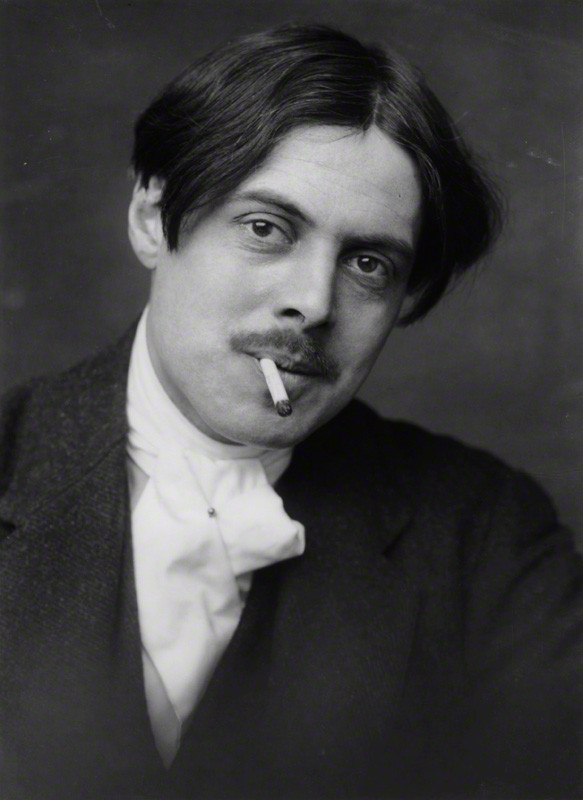 Nash's fellow students included Ben Nicholson, Stanley Spencer,
Nash's fellow students included Ben Nicholson, Stanley Spencer,
“In October 1910 a new set of students arrived at the Slade. They included William Roberts , gas attack by roberts
, gas attack by roberts
a gifted but scruffy schoolboy of fifteen, and Paul Nash, a handsome, smartly-dressed young man of twenty-one, who in his suit and spats seemed out of place amongst what he considered the “eccentric sartorials” of the Slade. [Christopher R. W.] Nevinson came up and loudly asked him if he was an engineer. Nash recalled how Nevinson’s barbed remark ‘got a laugh, and I felt a pariah. It meant that I did not “belong” and, looking round from [Mark] Gertler with his Swinburne locks and blue shirt to Roberts and [Stanley] Spencer with their uncompromising disregard for appearance, or Nevinson himself with his Quartier Latin tie and naive hat, I was forced to accept the implication.’ (A Crisis of Brilliance, David Haycock 2010, p. 65).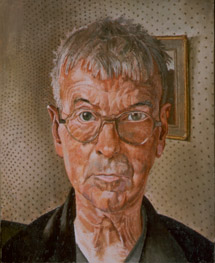 Mark Gertler, William Roberts, Dora Carrington,Christopher R. W. Nevinson and Edward Wadsworth. However, he struggled with figure drawing, and spent only a year at the School. Influenced by the poetry of William Blake and the paintings of Samuel Palmer and Dante Gabriel Rossetti, Nash had shows in 1912 and 1913 (sometimes alone, sometimes with his brother John), largely devoted to drawings and watercolours of brooding landscapes. By the summer of 1914 he was enjoying some success.At the outbreak of World War I, Nash reluctantly enlisted in the Artists' Rifles and was sent to france
Mark Gertler, William Roberts, Dora Carrington,Christopher R. W. Nevinson and Edward Wadsworth. However, he struggled with figure drawing, and spent only a year at the School. Influenced by the poetry of William Blake and the paintings of Samuel Palmer and Dante Gabriel Rossetti, Nash had shows in 1912 and 1913 (sometimes alone, sometimes with his brother John), largely devoted to drawings and watercolours of brooding landscapes. By the summer of 1914 he was enjoying some success.At the outbreak of World War I, Nash reluctantly enlisted in the Artists' Rifles and was sent to france
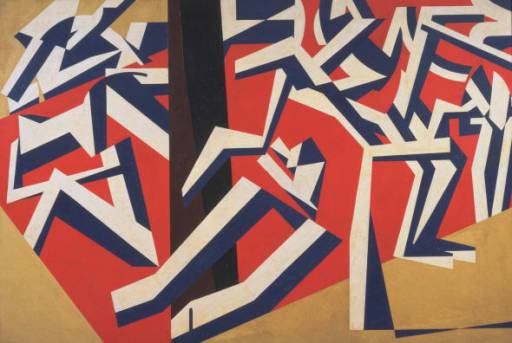
The Slade was then opening its doors to a remarkable crop of young talents – what Tonks later described as the School's second and last 'Crisis of Brilliance' (the first had seen such stars as Augustus John
 and Percy Wyndham Lewis).
and Percy Wyndham Lewis). Nash's fellow students included Ben Nicholson, Stanley Spencer,
Nash's fellow students included Ben Nicholson, Stanley Spencer, “In October 1910 a new set of students arrived at the Slade. They included William Roberts
 , gas attack by roberts
, gas attack by robertsa gifted but scruffy schoolboy of fifteen, and Paul Nash, a handsome, smartly-dressed young man of twenty-one, who in his suit and spats seemed out of place amongst what he considered the “eccentric sartorials” of the Slade. [Christopher R. W.] Nevinson came up and loudly asked him if he was an engineer. Nash recalled how Nevinson’s barbed remark ‘got a laugh, and I felt a pariah. It meant that I did not “belong” and, looking round from [Mark] Gertler with his Swinburne locks and blue shirt to Roberts and [Stanley] Spencer with their uncompromising disregard for appearance, or Nevinson himself with his Quartier Latin tie and naive hat, I was forced to accept the implication.’ (A Crisis of Brilliance, David Haycock 2010, p. 65).
 Mark Gertler, William Roberts, Dora Carrington,Christopher R. W. Nevinson and Edward Wadsworth. However, he struggled with figure drawing, and spent only a year at the School. Influenced by the poetry of William Blake and the paintings of Samuel Palmer and Dante Gabriel Rossetti, Nash had shows in 1912 and 1913 (sometimes alone, sometimes with his brother John), largely devoted to drawings and watercolours of brooding landscapes. By the summer of 1914 he was enjoying some success.At the outbreak of World War I, Nash reluctantly enlisted in the Artists' Rifles and was sent to france
Mark Gertler, William Roberts, Dora Carrington,Christopher R. W. Nevinson and Edward Wadsworth. However, he struggled with figure drawing, and spent only a year at the School. Influenced by the poetry of William Blake and the paintings of Samuel Palmer and Dante Gabriel Rossetti, Nash had shows in 1912 and 1913 (sometimes alone, sometimes with his brother John), largely devoted to drawings and watercolours of brooding landscapes. By the summer of 1914 he was enjoying some success.At the outbreak of World War I, Nash reluctantly enlisted in the Artists' Rifles and was sent to france
Simon Grant described the influence of war and death on Nash’s art thus:
” … beneath his quiet lyrical pastoralism was a much darker side, reflected in his lifelong preoccupation with the theme of mortality. While his love for landscape gave him his subject, it was the spectre of death that gave him his spirit. This was a sentiment that appeared throughout his career, from his early experiments with Romanticism. It was radically transformed by his experience on the Western Front, developed through the inter-war years, and took final shape in the Second World War paintings … When Nash returned to the Front as an official war artist to witness the aftermath of the battle of Passchendaele, what he saw radically transformed both his art and his attitude to death. The landscape that Nash had seen defiantly in bloom in the spring was now a barren, blasted quagmire, littered with the dead. Only the splintered stumps of trees remained. Nash expressed the death of the men through the death of nature in his chalk sketches. In a letter to his wife Margaret, he described what he saw as apocalyptic: ‘Evil and the incarnate fiend alone can be the master of the ceremonies in this war: no glimmer of God’s hand is seen. Sunset and sunrise are blasphemous mockeries to man; only the black rain out of the bruised and swollen clouds or through the bitter black of night is fit atmosphere in such a land.’ (Tate Magazine, issue 6).
what he saw radically transformed both his art and his attitude to death. The landscape that Nash had seen defiantly in bloom in the spring was now a barren, blasted quagmire, littered with the dead. Only the splintered stumps of trees remained. Nash expressed the death of the men through the death of nature in his chalk sketches. In a letter to his wife Margaret, he described what he saw as apocalyptic: ‘Evil and the incarnate fiend alone can be the master of the ceremonies in this war: no glimmer of God’s hand is seen. Sunset and sunrise are blasphemous mockeries to man; only the black rain out of the bruised and swollen clouds or through the bitter black of night is fit atmosphere in such a land.’ (Tate Magazine, issue 6).
the Western Front in February 1917 as asecond lieutenant in the Hampshire Regiment. A few days before the Ypres offensive he fell into a trench. He broke a rib and was invalided home. While recuperating in London, Nash worked from his front-line sketches to produce a series of drawings of the war. This work, which shows the influence of the literary magazine BLAST and the Vorticist movement of which it was a manifesto, was well received when exhibited later that year at the Goupil Gallery. what he saw radically transformed both his art and his attitude to death. The landscape that Nash had seen defiantly in bloom in the spring was now a barren, blasted quagmire, littered with the dead. Only the splintered stumps of trees remained. Nash expressed the death of the men through the death of nature in his chalk sketches. In a letter to his wife Margaret, he described what he saw as apocalyptic: ‘Evil and the incarnate fiend alone can be the master of the ceremonies in this war: no glimmer of God’s hand is seen. Sunset and sunrise are blasphemous mockeries to man; only the black rain out of the bruised and swollen clouds or through the bitter black of night is fit atmosphere in such a land.’ (Tate Magazine, issue 6).
what he saw radically transformed both his art and his attitude to death. The landscape that Nash had seen defiantly in bloom in the spring was now a barren, blasted quagmire, littered with the dead. Only the splintered stumps of trees remained. Nash expressed the death of the men through the death of nature in his chalk sketches. In a letter to his wife Margaret, he described what he saw as apocalyptic: ‘Evil and the incarnate fiend alone can be the master of the ceremonies in this war: no glimmer of God’s hand is seen. Sunset and sunrise are blasphemous mockeries to man; only the black rain out of the bruised and swollen clouds or through the bitter black of night is fit atmosphere in such a land.’ (Tate Magazine, issue 6).
As a result of this exhibition, Nevinson advised Nash to approach Charles Masterman, head of the government's War Propaganda Bureau (WPB). Nash was recruited as an official war artist, and in November 1917 he returned to the Western Front where his drawings resulted in his first oil paintings. Nash's work during the war included The Menin Road,  , The Ypres Salient at Night
, The Ypres Salient at Night , The Mule Track, A Howitzer Firing, Ruined Country and Spring in the Trenches. They are some of the most powerful and enduring images of the Great War painted by an English artist.
, The Mule Track, A Howitzer Firing, Ruined Country and Spring in the Trenches. They are some of the most powerful and enduring images of the Great War painted by an English artist.
 , The Ypres Salient at Night
, The Ypres Salient at Night , The Mule Track, A Howitzer Firing, Ruined Country and Spring in the Trenches. They are some of the most powerful and enduring images of the Great War painted by an English artist.
, The Mule Track, A Howitzer Firing, Ruined Country and Spring in the Trenches. They are some of the most powerful and enduring images of the Great War painted by an English artist.
Nash used his opportunity as a war artist to bring home the full horrors of the conflict. As he wrote to his wife from the front on 16 November 1917:
"I am no longer an artist. I am a messenger who will bring back word from the men who are fighting to those who want the war to go on for ever. Feeble, inarticulate will be my message, but it will have a bitter truth and may it burn their lousy souls."
In the early 1920s, Nash, along with several other artists became prominent in the Society of Wood Engravers and in 1920 was involved in its first exhibition. He became close friends with Eric Fitch Daglish. whom he educated in the art of wood engraving and Daglish as a result went on to become a successful engraver.
whom he educated in the art of wood engraving and Daglish as a result went on to become a successful engraver.
 whom he educated in the art of wood engraving and Daglish as a result went on to become a successful engraver.
whom he educated in the art of wood engraving and Daglish as a result went on to become a successful engraver.
Nash was also a pioneer of modernism in Britain, promoting the avant-garde European styles of abstraction and surrealism in the 1920s and 1930s. In 1933 he co-founded the influential modern art movement Unit One with fellow artists Henry Moore, Barbara Hepworth , Ben Nicholson
, Ben Nicholson , Edward Wadsworth
, Edward Wadsworth  and the critic Herbert Read. It was a short-lived but important move towards the revitalisation of British art in the inter-war period.
and the critic Herbert Read. It was a short-lived but important move towards the revitalisation of British art in the inter-war period.
 , Ben Nicholson
, Ben Nicholson , Edward Wadsworth
, Edward Wadsworth  and the critic Herbert Read. It was a short-lived but important move towards the revitalisation of British art in the inter-war period.
and the critic Herbert Read. It was a short-lived but important move towards the revitalisation of British art in the inter-war period.
During World War II Nash was again employed as an official war artist, this time by the Ministry of Information and the Air Ministry, and paintings he produced during this period include
and the Air Ministry, and paintings he produced during this period include  the Battle of Britain and dead sea
the Battle of Britain and dead sea Paul Nash’s famous painting, which seems to capture the intensity of the Luftwaffe’s last great assault, a day when, at one time, all of the RAF’s 176 serviceable planes were in the air. In real life, it’s a large canvas, with lots of detail; well worth visiting the Imperial War Museum to see.
Paul Nash’s famous painting, which seems to capture the intensity of the Luftwaffe’s last great assault, a day when, at one time, all of the RAF’s 176 serviceable planes were in the air. In real life, it’s a large canvas, with lots of detail; well worth visiting the Imperial War Museum to see.
 and the Air Ministry, and paintings he produced during this period include
and the Air Ministry, and paintings he produced during this period include  the Battle of Britain and dead sea
the Battle of Britain and dead sea Paul Nash’s famous painting, which seems to capture the intensity of the Luftwaffe’s last great assault, a day when, at one time, all of the RAF’s 176 serviceable planes were in the air. In real life, it’s a large canvas, with lots of detail; well worth visiting the Imperial War Museum to see.
Paul Nash’s famous painting, which seems to capture the intensity of the Luftwaffe’s last great assault, a day when, at one time, all of the RAF’s 176 serviceable planes were in the air. In real life, it’s a large canvas, with lots of detail; well worth visiting the Imperial War Museum to see.
The work of Paul Nash (1889-1946) is a fascinating portrayal of a generation whose lives were dominated by war and its affect on British society. Nash experienced the horror of the First World War on an immediate level when he fought near Ypres in early 1917. Although he was soon invalided out of frontline combat, the affect that war had upon his personal and artistic viewpoint is clearly visible in his such works as “The Ypres Salient by Night” (1918).
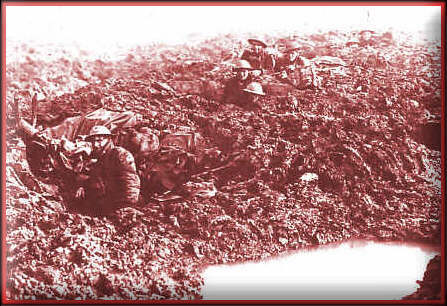
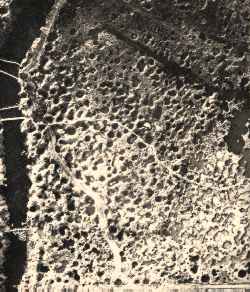 The trench cuts through the composition with dominant man-made forms, in which the figures huddle and shelter. However, the trench is surrounded by a fragmented world of chaos, a world where the conventions of day and night, order and disorder, no longer exist as bombing continues throughout the night. The figures outside of the trench appear isolated within the wasteland, surrounded by the destruction of war.
The trench cuts through the composition with dominant man-made forms, in which the figures huddle and shelter. However, the trench is surrounded by a fragmented world of chaos, a world where the conventions of day and night, order and disorder, no longer exist as bombing continues throughout the night. The figures outside of the trench appear isolated within the wasteland, surrounded by the destruction of war.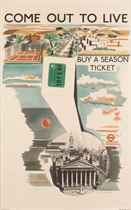 The remanence of tree trunks blasted by gunfire stand as a memory of the lost natural world, whilst the exploding shell throws unnatural shards of light upon the night sky. This highlights the industrial nature of modern warfare with the damage it has brought upon the natural order. This sense of fragmentation and the irreversible change upon the natural world is also a major theme in Nash's later works from the Second World War.
The remanence of tree trunks blasted by gunfire stand as a memory of the lost natural world, whilst the exploding shell throws unnatural shards of light upon the night sky. This highlights the industrial nature of modern warfare with the damage it has brought upon the natural order. This sense of fragmentation and the irreversible change upon the natural world is also a major theme in Nash's later works from the Second World War.
During the Second World War, Nash was one of many British artists who documented the war from the Home Front .BELOW PANTILE COTTAGE DYMCHURCH
.BELOW PANTILE COTTAGE DYMCHURCH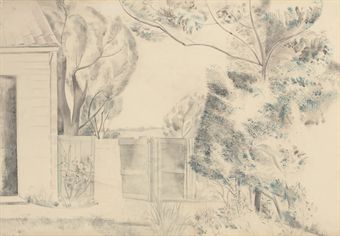 In Totes Meer (Dead Sea) (1940-1941), the escalation of industrialised warfare is shown to have
In Totes Meer (Dead Sea) (1940-1941), the escalation of industrialised warfare is shown to have  developed to where war is a constant presence in the British psyche.
developed to where war is a constant presence in the British psyche. The natural landscape of the sea and the land is present, however an inability to distinguish between
The natural landscape of the sea and the land is present, however an inability to distinguish between the strong waves of the sea and the military wreckage shows the absolute and unavoidable nature of war like the unstoppable tides.
the strong waves of the sea and the military wreckage shows the absolute and unavoidable nature of war like the unstoppable tides. 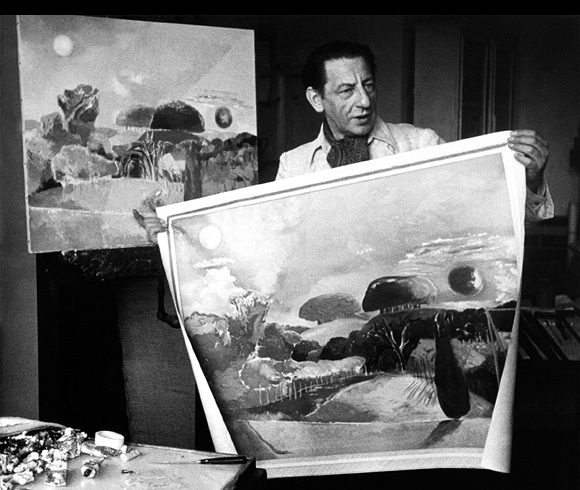
e
 The trench cuts through the composition with dominant man-made forms, in which the figures huddle and shelter. However, the trench is surrounded by a fragmented world of chaos, a world where the conventions of day and night, order and disorder, no longer exist as bombing continues throughout the night. The figures outside of the trench appear isolated within the wasteland, surrounded by the destruction of war.
The trench cuts through the composition with dominant man-made forms, in which the figures huddle and shelter. However, the trench is surrounded by a fragmented world of chaos, a world where the conventions of day and night, order and disorder, no longer exist as bombing continues throughout the night. The figures outside of the trench appear isolated within the wasteland, surrounded by the destruction of war. The remanence of tree trunks blasted by gunfire stand as a memory of the lost natural world, whilst the exploding shell throws unnatural shards of light upon the night sky. This highlights the industrial nature of modern warfare with the damage it has brought upon the natural order. This sense of fragmentation and the irreversible change upon the natural world is also a major theme in Nash's later works from the Second World War.
The remanence of tree trunks blasted by gunfire stand as a memory of the lost natural world, whilst the exploding shell throws unnatural shards of light upon the night sky. This highlights the industrial nature of modern warfare with the damage it has brought upon the natural order. This sense of fragmentation and the irreversible change upon the natural world is also a major theme in Nash's later works from the Second World War. |
| Paul Nash 'Totes Meer (Dead Sea)' 1940-1941. |
During the Second World War, Nash was one of many British artists who documented the war from the Home Front
 .BELOW PANTILE COTTAGE DYMCHURCH
.BELOW PANTILE COTTAGE DYMCHURCH In Totes Meer (Dead Sea) (1940-1941), the escalation of industrialised warfare is shown to have
In Totes Meer (Dead Sea) (1940-1941), the escalation of industrialised warfare is shown to have  developed to where war is a constant presence in the British psyche.
developed to where war is a constant presence in the British psyche. The natural landscape of the sea and the land is present, however an inability to distinguish between
The natural landscape of the sea and the land is present, however an inability to distinguish between the strong waves of the sea and the military wreckage shows the absolute and unavoidable nature of war like the unstoppable tides.
the strong waves of the sea and the military wreckage shows the absolute and unavoidable nature of war like the unstoppable tides. 
Nash found much inspiration in British landscape, particularly landscapes with a sense of ancient history, such as burial mounds, Iron Age hill forts such as Wittenham Clumps
 and the standing stones at Avebury in Wiltshire.
and the standing stones at Avebury in Wiltshire. When in 1932 he was invited to illustrate a book of his own choice Nash unhesitating choose Sir Thomas Browne's Urn Burial and The Garden of Cyrus providing the publisher with a set of no less than 32 illustrations to accompany Browne's Discourses. In his final years, he also returned to the influence of Blake that had so affected his early art, for example in the series of gigantic sunflowers including Sunflower and Sun (1942) and Eclipse of the Sunflower (1945) based on Blake's poem Ah! Sunflower.In 1914 Nash married Margaret Odeh, an Oxford-educated campaigner for Women's Suffrage. They had no children.
When in 1932 he was invited to illustrate a book of his own choice Nash unhesitating choose Sir Thomas Browne's Urn Burial and The Garden of Cyrus providing the publisher with a set of no less than 32 illustrations to accompany Browne's Discourses. In his final years, he also returned to the influence of Blake that had so affected his early art, for example in the series of gigantic sunflowers including Sunflower and Sun (1942) and Eclipse of the Sunflower (1945) based on Blake's poem Ah! Sunflower.In 1914 Nash married Margaret Odeh, an Oxford-educated campaigner for Women's Suffrage. They had no children.
(Photo: S. Klinge)

Paul Nash (National Portrait Gallery)

“Margaret was private secretary to the organiser of the Tax Resistance League, a Suffrage organisation that helped women who refused to pay their taxes. One activity Margaret organised was the auctions where non-payers were forced to sell off their possessions in lieu of their tax debts. Nash accompanied her to a sale in Tottenham Court Road, and was astounded at what happened … the women speakers ‘stormed and shouted against the hooting crowd,’ some of whom threw mud, stones and eggs, whilst ‘Government men’ stirred up the trouble. The worst protesters were medical students. ‘What you want, sweetheart,’ one growled, grinning into Margaret’s face, ‘is raping.’ She struck him across the face with a horsewhip and drew blood. Standing on top of a horse-drawn milk cart, brandishing her whip, Nash likened her to ‘a new kind of Boadicea, scattering the enemy hordes.’

Mageret Odehs work
"When I was young, my parents used to keep bees on a wooded patch of land outside our home town of Newbury. I was always curious about the old ruins on the site amidst the trees, which suggested a house had once stood there. A manmade lake, now stagnant and dark, stood in the grounds, and away from the buzzing of the beehives the atmosphere was made eerie by looming specimen trees clearly planted by human hands. It was only much later in life, after starting my undergraduate degree in history, that I began delving into the story of what the ruins had been.

What I found astonished me. The house had been an old mansion by the name of Cope Hall – and besides an illustrious past that took in the Civil War and several generations of keen Victorian
 gardeners who had built the extensive grounds, the Hall harboured a secret. During the dying days of World War One, it had played host to a reformatory for female prostitutes, known as the Women’s Training Colony. There, in the leafy fastness of the Home Counties, ‘fallen women’ from the heart of Edwardian London had been sent to learn arts-and-crafts skills and fashion a new life for themselves in the fresh air. It was a story that, I discovered, had lain hidden within dusty archives and under the ruins of Cope Hall for eighty years, and I was to be the first to re-tell it. So fascinating was the story behind the Women’s Training Colony, that I decided to make it the subject of my undergraduate dissertation; you can find the full document for download below. But for those of you who can’t stomach 12,000 words, here’s a quick taster.
gardeners who had built the extensive grounds, the Hall harboured a secret. During the dying days of World War One, it had played host to a reformatory for female prostitutes, known as the Women’s Training Colony. There, in the leafy fastness of the Home Counties, ‘fallen women’ from the heart of Edwardian London had been sent to learn arts-and-crafts skills and fashion a new life for themselves in the fresh air. It was a story that, I discovered, had lain hidden within dusty archives and under the ruins of Cope Hall for eighty years, and I was to be the first to re-tell it. So fascinating was the story behind the Women’s Training Colony, that I decided to make it the subject of my undergraduate dissertation; you can find the full document for download below. But for those of you who can’t stomach 12,000 words, here’s a quick taster.
Edwardian Britain was a society that still viewed prostitution with no small degree of suspicion. Though the stigma attached to prostitutes had faded since the dark days of the Contagious Diseases Acts – when women suspected of harbouring venereal disease could be locked up and subjected to compulsory inspection – the prevailing attitude was still one of ensuring ‘social purity’ through penalising female prostitutes rather than their clientele. Social work was still dominated by Christian missions and probation for young people in its infancy. Into this unpromising environment was born an intriguing new organisation: the Committee for Social Investigation and Reform (CSIR). Its grandiose name was highly establishment, but its founders and associates were not; many came from the suffragist and suffragette movements, with big-name donors including Elizabeth Garrett Anderson and Millicent Fawcett
 . One of the principal founders of the organisation was Margaret Odeh, the wife of wartime artist Paul Nash, who before taking up the plight of female prostitutes had been part of the Women’s Tax Resistance League, and had taken to carrying a bull-whip to deter hecklers. Another key figure was Captain Arthur St John, a former fusilier in the Burmese wars who had read Tolstoy, become an anarchist and helped to resettle a pacifist tribe from Russia to Canada. The unorthodox and radical politics of the founders helped shape the outlook of the CSIR’s efforts – one aspect of which was the Women’s Training Colony.
. One of the principal founders of the organisation was Margaret Odeh, the wife of wartime artist Paul Nash, who before taking up the plight of female prostitutes had been part of the Women’s Tax Resistance League, and had taken to carrying a bull-whip to deter hecklers. Another key figure was Captain Arthur St John, a former fusilier in the Burmese wars who had read Tolstoy, become an anarchist and helped to resettle a pacifist tribe from Russia to Canada. The unorthodox and radical politics of the founders helped shape the outlook of the CSIR’s efforts – one aspect of which was the Women’s Training Colony.
Between 1934 and 1936 Paul Nash lived near Swanage, Dorset. He produced a considerable number of paintings and photographs during this period.

“For 35 years, Nash painted a small range of elemental things – trees and tree trunks, knapped flints, birds’ nests, doorways – regrouping them like pieces on a chessboard, or like soldiers on a battle plan. For the most part, these scenes were imagined, their elements and the arrangement of those elements so charged with symbolism that even Nash’s landscapes really count as still lifes. The idea that Nash recorded what he saw, on the Menin Road or by the sea in Dymchurch , needs knocking on the head … Above all, you feel, there is sex. Nash, unusually open to the European avant-garde, was an early subscriber to Surrealism.
, needs knocking on the head … Above all, you feel, there is sex. Nash, unusually open to the European avant-garde, was an early subscriber to Surrealism.  Dymchurch is a village and civil parish in the Shepway District of Kent, England. The village is located on the coast five miles (8 km) south-west of Hythe,
Dymchurch is a village and civil parish in the Shepway District of Kent, England. The village is located on the coast five miles (8 km) south-west of Hythe, and on the Romney Marsh.
and on the Romney Marsh. This suited him well in various ways, the improbable juxtaposing of unlikely objects being at the heart of Surrealism’s method and his own. The surrealist taste for things erotic also shades the paths through Nash’s woods, his fascination with dew ponds and standing stones, with fallen trees. One work in particular – The Archer, first painted in 1930 and reworked over the course of a dozen years – seems to unlock Nash. The po-faced depiction of an upended toy boat, its mast pointing at a target, The Archer is like the illustration from a Freudian casebook. Behind its child-like innocence, lie the irrationality of Freud’s The Interpretation of Dreams, the mythic quality of The Golden Bough.” (The Independent, 14th February 2010).Nash was asked by John Betjeman to write a book in the pre-war Shell Guide series. Nash accepted and compiled a guide to Dorset which features some peculiarities of landscape and architecture that are often overlooked. The guide was published in 1935 and is now particularly rare.
This suited him well in various ways, the improbable juxtaposing of unlikely objects being at the heart of Surrealism’s method and his own. The surrealist taste for things erotic also shades the paths through Nash’s woods, his fascination with dew ponds and standing stones, with fallen trees. One work in particular – The Archer, first painted in 1930 and reworked over the course of a dozen years – seems to unlock Nash. The po-faced depiction of an upended toy boat, its mast pointing at a target, The Archer is like the illustration from a Freudian casebook. Behind its child-like innocence, lie the irrationality of Freud’s The Interpretation of Dreams, the mythic quality of The Golden Bough.” (The Independent, 14th February 2010).Nash was asked by John Betjeman to write a book in the pre-war Shell Guide series. Nash accepted and compiled a guide to Dorset which features some peculiarities of landscape and architecture that are often overlooked. The guide was published in 1935 and is now particularly rare.
 , needs knocking on the head … Above all, you feel, there is sex. Nash, unusually open to the European avant-garde, was an early subscriber to Surrealism.
, needs knocking on the head … Above all, you feel, there is sex. Nash, unusually open to the European avant-garde, was an early subscriber to Surrealism.  Dymchurch is a village and civil parish in the Shepway District of Kent, England. The village is located on the coast five miles (8 km) south-west of Hythe,
Dymchurch is a village and civil parish in the Shepway District of Kent, England. The village is located on the coast five miles (8 km) south-west of Hythe, This suited him well in various ways, the improbable juxtaposing of unlikely objects being at the heart of Surrealism’s method and his own. The surrealist taste for things erotic also shades the paths through Nash’s woods, his fascination with dew ponds and standing stones, with fallen trees. One work in particular – The Archer, first painted in 1930 and reworked over the course of a dozen years – seems to unlock Nash. The po-faced depiction of an upended toy boat, its mast pointing at a target, The Archer is like the illustration from a Freudian casebook. Behind its child-like innocence, lie the irrationality of Freud’s The Interpretation of Dreams, the mythic quality of The Golden Bough.” (The Independent, 14th February 2010).Nash was asked by John Betjeman to write a book in the pre-war Shell Guide series. Nash accepted and compiled a guide to Dorset which features some peculiarities of landscape and architecture that are often overlooked. The guide was published in 1935 and is now particularly rare.
This suited him well in various ways, the improbable juxtaposing of unlikely objects being at the heart of Surrealism’s method and his own. The surrealist taste for things erotic also shades the paths through Nash’s woods, his fascination with dew ponds and standing stones, with fallen trees. One work in particular – The Archer, first painted in 1930 and reworked over the course of a dozen years – seems to unlock Nash. The po-faced depiction of an upended toy boat, its mast pointing at a target, The Archer is like the illustration from a Freudian casebook. Behind its child-like innocence, lie the irrationality of Freud’s The Interpretation of Dreams, the mythic quality of The Golden Bough.” (The Independent, 14th February 2010).Nash was asked by John Betjeman to write a book in the pre-war Shell Guide series. Nash accepted and compiled a guide to Dorset which features some peculiarities of landscape and architecture that are often overlooked. The guide was published in 1935 and is now particularly rare.
Nash died of heart failure on 11 July 1946, at Boscombe , Hampshire (now Dorset) and was buried on 17 July, in the churchyard of St. Mary's Church, Langley, Buckinghamshire (now Berkshire).
, Hampshire (now Dorset) and was buried on 17 July, in the churchyard of St. Mary's Church, Langley, Buckinghamshire (now Berkshire).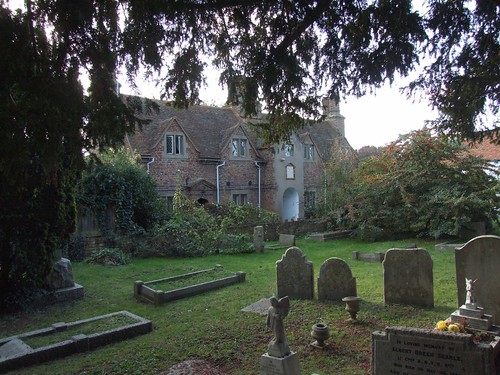 Nash will be showing at the uk biennial in liverpool.see ad
Nash will be showing at the uk biennial in liverpool.see ad
 , Hampshire (now Dorset) and was buried on 17 July, in the churchyard of St. Mary's Church, Langley, Buckinghamshire (now Berkshire).
, Hampshire (now Dorset) and was buried on 17 July, in the churchyard of St. Mary's Church, Langley, Buckinghamshire (now Berkshire). Nash will be showing at the uk biennial in liverpool.see ad
Nash will be showing at the uk biennial in liverpool.see ad
No comments:
Post a Comment